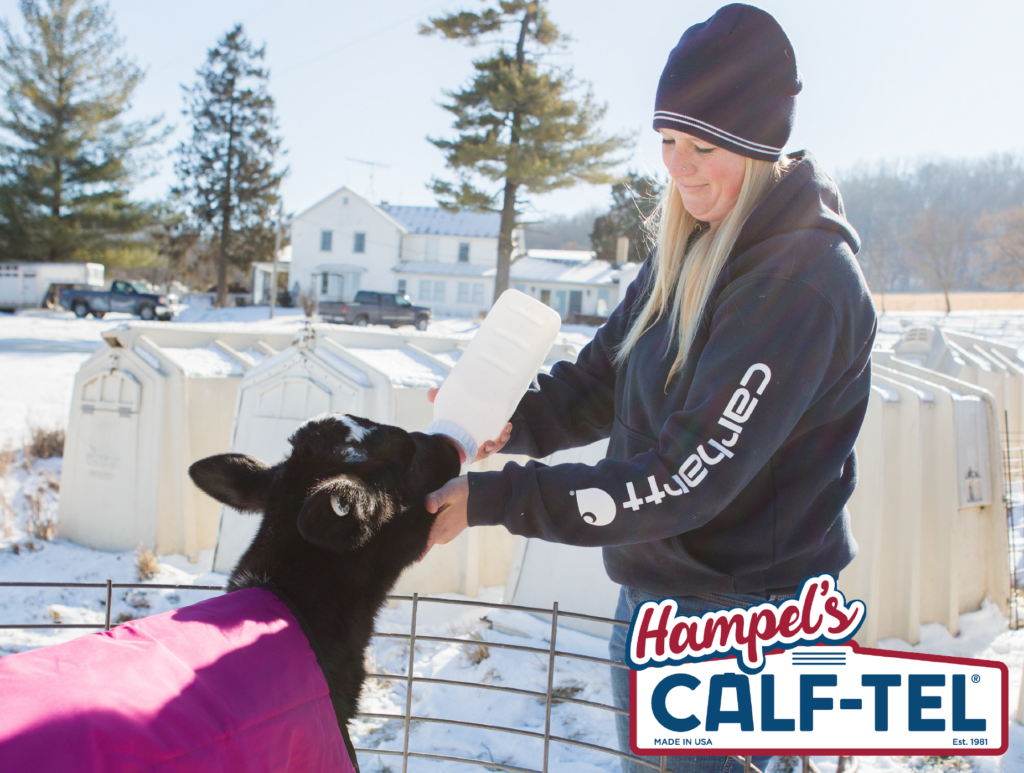
Fall weather is certainly here and the cooler temperatures often require the calf feeder to wear a jacket, but do you ever wonder how these cooler temperatures impact our calves? A calf is below its “thermal neutral zone” when the environmental temperature drops below 60 degrees Fahrenheit, meaning she is now spending extra energy to stay warm rather than using those calories for growth. (Leadley)
Newborn calves have only 3-4% body fat, which is not much to spare when trying to stay warm in the colder weather. Lower temperatures can be dangerous and even life threatening to calves under three weeks of age because they consume less starter. If a calf is not getting enough energy, starvation occurs, shutting down body systems to preserve energy. The first system that shuts down is the immune system. (Breuer) Assuring that calves get enough calories to grow and remain healthy means that feeding and management practices often require some adjustments in colder weather.
Here are some tips to help calves succeed:
1. Make sure calves are towel dried after birth and placed in a warming box with a heat lamp or a heated room until their hair coat is dry. A fluffy, dry hair coat acts as an insulating layer between the calf’s skin and the outside temperatures.
2. After the calf is dry, be sure to fit it with a clean calf jacket for the first three weeks of life. When using a jacket, it is recommended to adjust the straps weekly and also doing a health evaluation of body condition score and respiration rates of the calf while adjusting the straps. (Lee) Calf-Tel calf jackets contain 200 grams of Thinsulate insulation and are perfect for use in cold conditions.

3. Get more calories into the calf. Some calf raisers do this by adding a third feeding (example: 6am, 1 pm, and 7pm feedings). (Breuer) Another option is to switch to a milk replacer that has a higher fat content or add an additional fat supplement to a pre-existing milk replacer. Be sure to follow the label directions when using these products. Regardless of which option used, the goal is to get more calories into the calf. A standard milk replacer diet of 20:20 milk replacer powder in 2 quarts of water will simply NOT provide enough energy for warmth and growth in cold weather. (Breuer) Calves being fed a full 4-quart Calf-Tel bottle of milk or replacer at least twice daily will be much less likely to experience cold stress because of the amount of nutrition they are receiving daily.
4. Feed warm water shortly after each milk feeding, ideally within 15-30 minutes. The water should be delivered above 102 degrees so the calf is not expending energy to warm up the water in their stomach. It is a good practice to dump any leftover water after the calf lays down, so it doesn’t freeze.
5. Encourage calves to eat more calf starter or grain by providing fresh, clean feed daily in buckets at a height they can easily reach. Starter is another good way to provide a fat and energy source to calves during cold weather. The heat of rumination will also help to keep the calf warm. (Lee)
6. Provide the calf enough dry straw to be able to nest down in. They should not be laying on top of their bedding and it is ideal when their legs are not visible in the straw. Newborn calves will lie down more than 90 percent of the time and it is important to insulate them from the concrete or moist, cold ground below them. One way to test this is to crawl into the pen or hutch and kneel there for a full minute. If your knees are wet when you stand, the insulating value of your bedding is low. (Leadley)
7. Fresh air is important, even in cold weather. The air exchange is important to remove any gasses or moisture from the air, but it is important that the air movement is not creating a draft on newborn and young calves. Calf-Tel hutches are specifically designed with ridge vents to keep fresh air moving and prevent condensation from building up inside the hutch, resulting in a much healthier environment for young calves.
To get a real idea of the calf’s environment, remove your jacket and spend 30-45 minutes with them. Are you cold, damp or looking for a drink of warm water and a snack? Please talk with your veterinarian and farm management team and make the necessary adjustments to accomplish the goal of healthy, growing, comfortable calves – no matter what the thermometer indicates.
Kelly Driver has been involved in the New York dairy industry all her life. In addition to raising dairy calves and replacement heifers, she is the Northeast Territory Manager for Calf-Tel. Feel free to contact her at kellydriver@hampelcorp.com with your calf questions or suggest a topic you would like covered in a future blog.
Sources:
- Breuer, Dr. Ryan, DVM. (Internet). Cold Weather Calf Care. Retrieved from https://www.extension.iastate.edu/dairyteam/files/…
- Leadley, Dr. Sam, Ph.D. (Internet). Fall Weather and Newborn Calves: Part 1. Retrieved from http://atticacows.com/library/newsletters/CESeptem…
- Lee, Karen. (2013, December 2). 10 tips for raising calves in cold weather. Progressive Dairyman Extra.
Courtesy of our dealer – CRI REPRODUCCIÓN ANIMAL MÉXICO SA DE CV.
